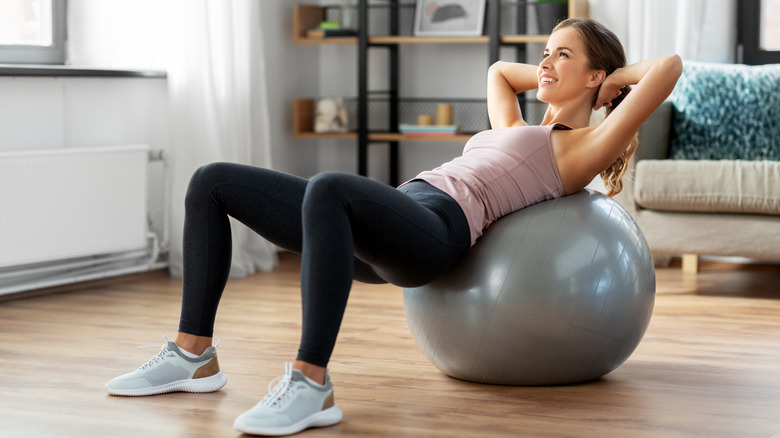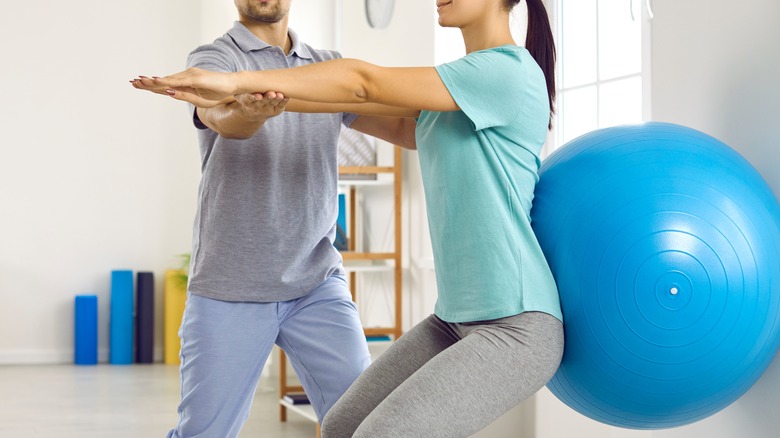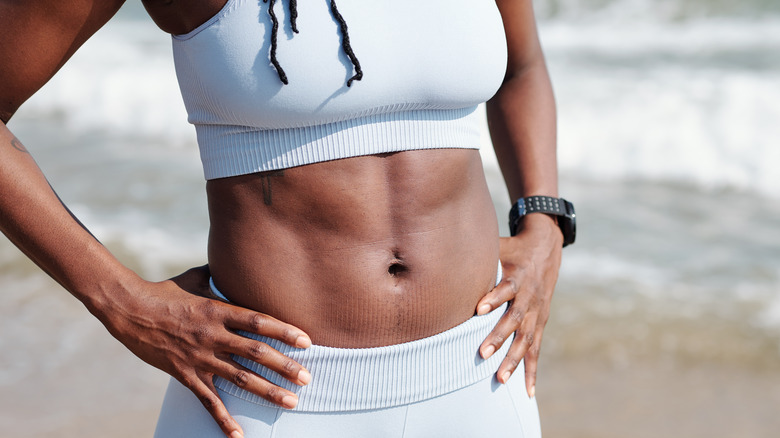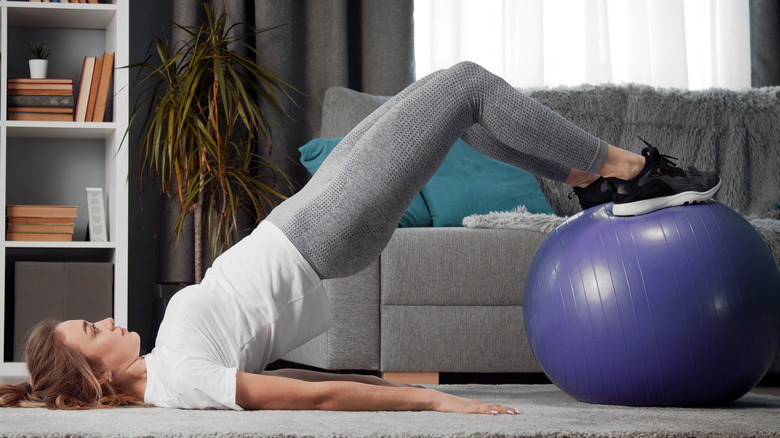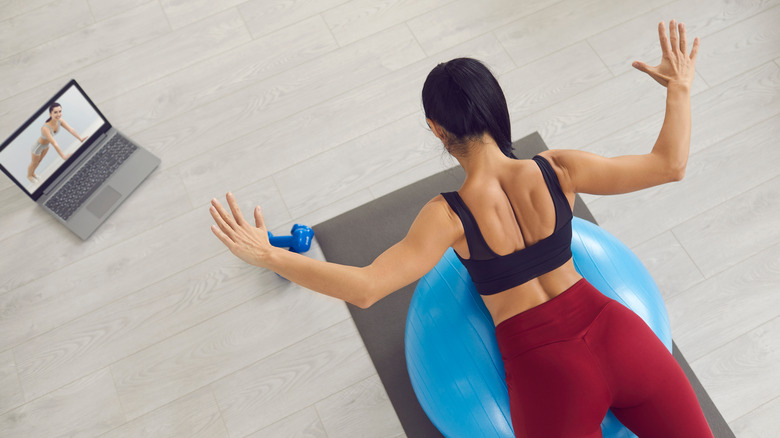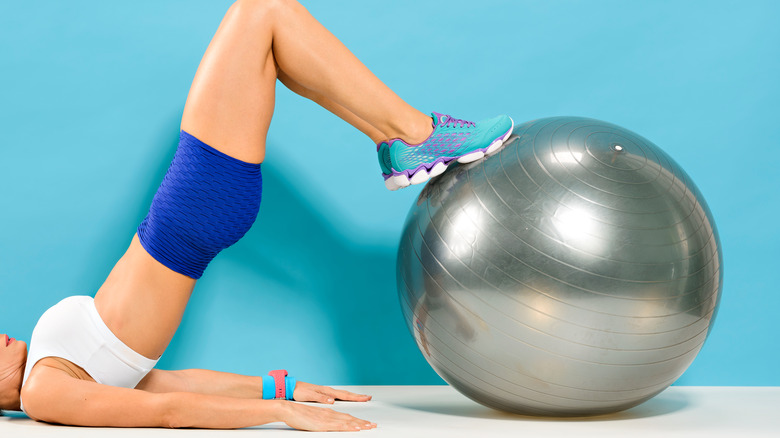Five Simple Stability Ball Exercises You Can Do In Your Living Room
Stability ball exercises are an integral component of balance training and can lead to a stronger core, increased flexibility, and greater range of motion. What's more, they strengthen the lower back muscles and may improve your posture, explains North Central Surgical Center Hospital. Depending on your needs, you can use stability balls for stretching, core work, and more. Sitting on a stability ball while working will make your abs work harder and help you burn extra calories, according to American Fitness Professionals and Associates.
Balance and stability training can benefit athletes, too. "Any time you improve stability, you improve the likelihood of better performance across the spectrum of athletic goals," exercise physiologist Douglas Brooks tells Oxygen Magazine. This form of training can also help you identify muscle imbalances and other physical weaknesses, says Brooks. But that's not all. As it turns out, stability training can boost muscular endurance and allow you to work out harder for longer, suggests a recent study featured in the Journal of Musculoskeletal and Neuronal Interactions.
The best part is, you don't need a gym membership to reap these benefits. Stability balls are relatively compact and inexpensive, which makes them suitable for at-home workouts. Plus, they come in different sizes and can be used along with other fitness accessories, such as dumbbells or resistance bands.
Ready to give it a try? Here are five simple stability ball exercises you can do in your living room.
Build leg strength with stability ball squats
Touted as the king of leg exercises, the squat targets your quads, hamstrings, calves, and deep abdominal muscles. The back and pelvic floor muscles come into play, too, points out the National Academy of Sports Medicine (NASM). With regular practice, this compound movement can boost your strength, power, and endurance, leading to enhanced physical performance. What's more, it improves bone mineral density and may protect against osteoporosis, according to clinical research presented in the Journal of Strength and Conditioning.
The NASM talks mostly about the benefits of barbell back squats, but that's not your only option. This exercise has dozens of variations, from box squats and sumo squats to split squats and plie squats, per NASM. Muscle and Fitness recommends starting with stability ball wall squats to build up your strength. You may also incorporate this movement into your warm-up routine or perform it at the end of your workout to achieve muscle failure.
First, place the ball against a wall and then lean against it. Keep your back straight and your legs hip-width apart. Extend your arms in front of you or place them on the hips. Slowly bend your knees until your thighs are parallel to the floor. Squeeze your core and glutes as you perform the movement. Return to the initial position and repeat. Wrap an elastic band around your knees or hold a dumbbell in each hand to make the exercise more challenging.
Work your abs with kneeling ABCs
Tired of sit-ups and crunches? Then it might be time to try something new and possibly more effective. We're talking about kneeling ABCs, a core movement recommended by the American Council on Exercise (ACE). Sit on your knees with a stability ball in front of you. Place your elbows and forearms on the ball, brace your core, and lean forward at a 45-degree angle. Next, move your elbows over the ball to bring it under your shoulders. Use your core muscles to control the movement. Maintain a neutral spine and avoid arching your neck or back. Later, try to use your elbows to "draw" the letters of the alphabet on top of the ball.
This movement is more challenging than it looks, but it's worth the effort. A strong core can make everyday activities easier, reduce injury risk, and enhance your balance, explains Harvard Medical School. In the long run, it may prevent low back pain and boost functional fitness while improving your posture.
"While back injuries are very common with a weak core, you can also injure other parts of your body as a result, like your shoulders, hips, and knees," says personal trainer Meredith McHale in an interview with SHAPE. Your core muscles wrap around the torso and spine, acting as a brace. The stronger they are, the better your balance and stability.
Try the glute bridge for a firm butt
The gluteal muscles do more than just make us look great in leggings and jeans. They also support our posture and contribute to our overall strength, speed, and endurance, notes Men's Health. "Whether you're lifting, jumping, sprinting, or shooting a basketball, your glutes are key to tapping into that explosive push-off strength that comes from extending your hips," explains sports medicine physician Dr. Jordan Metzl. Moreover, these muscles allow you to walk upright, change direction, maintain your balance, and move your legs.
Deadlifts and back squats are some of the best exercises for a firm butt, says Healthline, but they involve a steep learning curve. It takes just one wrong move to injure your back or knees, especially if you're a newbie. A safer option is the glute bridge, a compound movement that also hits your legs, hips, and core muscles. This exercise doesn't necessarily require a stability ball, but using one will challenge your balance and make your glutes work harder.
To get started, lie on your back and place your feet on top of the ball. Squeeze your abs and glutes while pushing through the heels to lift your hips, recommends strength and conditioning coach Yuri Elkaim. Hold the contraction for a second or two and then slowly return to the initial position. As you progress, try more advanced variations, such as the single-leg bridge, banded glute bridges, or weighted bridges.
Do stability ball I-Y-Ts for good posture
Prolonged sitting can affect your posture and lead to back pain in the long run. This habit also affects your neck, hips, knees, and feet, putting you at risk for injury. "You could even compress nerves and develop common issues like sciatica from sitting too much," osteopathic physician Elan Goldwaser tells NewYork-Presbyterian. Regular exercise cannot compensate for prolonged sitting, but it may reduce its impact on the spine and joints.
For starters, add stability ball I-Y-Ts to your workout routine. This movement targets the muscles that stabilize your shoulders and middle back, which may counteract some of the effects of sitting, says Beachbody on Demand. Place a stability ball under your chest and belly, with the legs extended behind you. Brace your core and squeeze your shoulder blades while raising the arms as close to your ears as you can. At this point, your body should form the letter "I." Maintain a neutral spine and keep your arms straight throughout the movement.
Next, lower your arms back to the floor and lift them diagonally so that your body forms the letter "Y." Bring your arms down again and raise them to your sides. If you do it right, your body will look like the letter "T." That's one set. Let your arms hang down and repeat. As you get stronger, you should be able to perform this exercise with a dumbbell in each hand.
Shape your thighs with hamstring curls
Tight hamstrings, a side effect of prolonged sitting, are prone to strains and other injuries, warns Harvard Medical School. Likewise, having weak hamstrings can increase injury risk and affect sports performance. Over time, these problems may result in lower back pain, abnormal gait, and knee issues, according to the Physical Therapy and Sports Medicine Institute. One way to activate and strengthen these muscles is to incorporate hamstring curls into your workout. And no, you don't need a gym machine to get things done.
ACE recommends using a stability ball for hamstring curls. Simply lie on your back with your calves and feet on the ball. Bring your arms to your sides and extend them fully so that your upper body forms the letter "T." Later, you'll use your arms for support.
Squeeze your glutes and engage your core while raising the hips. Bend your knees and let your lower legs slide over the ball, bringing it underneath you with your heels. Slowly extend your legs and lower your hips while pushing the ball back to its initial position. Remember to keep your back straight at all times. If you're up for a challenge, place your arms on the chest or hips or bring your feet closer together on the ball. Another option is to perform this movement with one leg at a time, suggests ACE.

